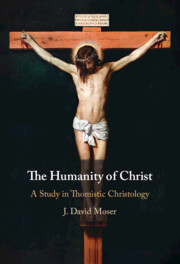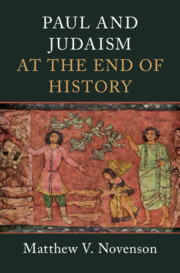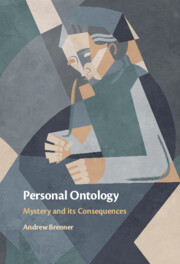Refine search
Actions for selected content:
92 results
1 - Scripture and Conciliar Teaching
- from Part I - Foundations and Statements of the Doctrine
-
- Book:
- The Humanity of Christ as Instrument of Salvation
- Published online:
- 21 August 2025
- Print publication:
- 04 September 2025, pp 15-30
-
- Chapter
- Export citation

The Humanity of Christ as Instrument of Salvation
- A Study in Thomistic Christology
-
- Published online:
- 21 August 2025
- Print publication:
- 04 September 2025
16 - Preaching on Heaven and Its Peace
- from Part III - Augustine’s Preaching Themes
-
-
- Book:
- The Cambridge Companion to Augustine's Sermons
- Published online:
- 26 May 2025
- Print publication:
- 12 June 2025, pp 299-316
-
- Chapter
- Export citation
Transforming Mortality: Paul’s Linguistic Expressions and Thought Development from 1 Cor 12:13 to 2 Cor 4:7–12
-
- Journal:
- Harvard Theological Review / Volume 118 / Issue 2 / April 2025
- Published online by Cambridge University Press:
- 30 July 2025, pp. 222-241
- Print publication:
- April 2025
-
- Article
- Export citation
DEATH, RESURRECTION, AND REALISM IN EURIPIDES’ ALCESTIS
-
- Journal:
- Greece & Rome / Volume 72 / Issue 1 / April 2025
- Published online by Cambridge University Press:
- 18 March 2025, pp. 109-125
- Print publication:
- April 2025
-
- Article
-
- You have access
- Open access
- HTML
- Export citation
10 - God’s Unbreakable Purpose
- from Part III - Reconfiguring the Story
-
- Book:
- Constructing an Incarnational Theology
- Published online:
- 09 January 2025
- Print publication:
- 23 January 2025, pp 244-281
-
- Chapter
- Export citation
Eἴ πως and Paul’s Hope for Death before the Parousia (Phil 3.11)
-
- Journal:
- New Testament Studies / Volume 71 / Issue 1 / January 2025
- Published online by Cambridge University Press:
- 07 August 2025, pp. 1-11
- Print publication:
- January 2025
-
- Article
-
- You have access
- Open access
- HTML
- Export citation
Chapter 4 - Not to Be – To Be
-
- Book:
- Shakespeare's Political Spirit
- Published online:
- 12 December 2024
- Print publication:
- 19 December 2024, pp 151-189
-
- Chapter
- Export citation
5 - The Risen Jesus
- from Part I - Origins
-
-
- Book:
- The New Cambridge Companion to Jesus
- Published online:
- 15 November 2024
- Print publication:
- 05 December 2024, pp 72-87
-
- Chapter
- Export citation
The problem of history in Thomas Torrance and Bernard Lonergan
-
- Journal:
- Scottish Journal of Theology / Volume 78 / Issue 1 / February 2025
- Published online by Cambridge University Press:
- 26 November 2024, pp. 61-74
- Print publication:
- February 2025
-
- Article
- Export citation
God of Promise and Voucher: Alienation, Reconciliation, and Resurrection
-
- Journal:
- New Blackfriars / Volume 105 / Issue 6 / November 2024
- Published online by Cambridge University Press:
- 25 October 2024, pp. 621-635
- Print publication:
- November 2024
-
- Article
-
- You have access
- Open access
- HTML
- Export citation

Paul and Judaism at the End of History
-
- Published online:
- 23 October 2024
- Print publication:
- 10 October 2024
8 - Personal Ontology and Life after Death, Part 1: Resurrection, Reincarnation
-
- Book:
- Personal Ontology
- Published online:
- 07 March 2024
- Print publication:
- 14 March 2024, pp 159-181
-
- Chapter
- Export citation

Personal Ontology
- Mystery and Its Consequences
-
- Published online:
- 07 March 2024
- Print publication:
- 14 March 2024
Philosophy’s Resurrection: Richard Fishacre on Theology, Light, and the Stars
-
- Journal:
- New Blackfriars / Volume 105 / Issue 4 / July 2024
- Published online by Cambridge University Press:
- 19 February 2024, pp. 384-400
- Print publication:
- July 2024
-
- Article
-
- You have access
- Open access
- HTML
- Export citation
7 - The Mystery of Israel’s Salvation
-
- Book:
- Paul and the Resurrection of Israel
- Published online:
- 02 November 2023
- Print publication:
- 23 November 2023, pp 271-322
-
- Chapter
- Export citation
6 - God’s Justice and the End of the Torah
-
- Book:
- Paul and the Resurrection of Israel
- Published online:
- 02 November 2023
- Print publication:
- 23 November 2023, pp 221-270
-
- Chapter
- Export citation
2 - Paul and the Israel Problem
-
- Book:
- Paul and the Resurrection of Israel
- Published online:
- 02 November 2023
- Print publication:
- 23 November 2023, pp 68-106
-
- Chapter
- Export citation
8 - The End of the Matter
-
- Book:
- Paul and the Resurrection of Israel
- Published online:
- 02 November 2023
- Print publication:
- 23 November 2023, pp 323-347
-
- Chapter
- Export citation
10 - A Resurrected Body
- from Part III - The Body of Christ
-
- Book:
- An Augustinian Christology
- Published online:
- 02 November 2023
- Print publication:
- 16 November 2023, pp 342-377
-
- Chapter
- Export citation
